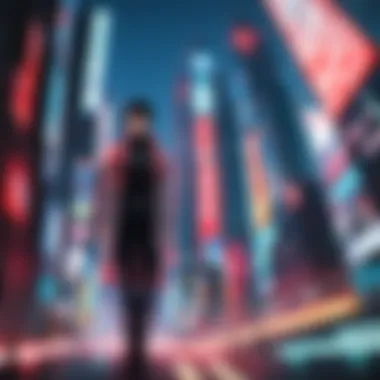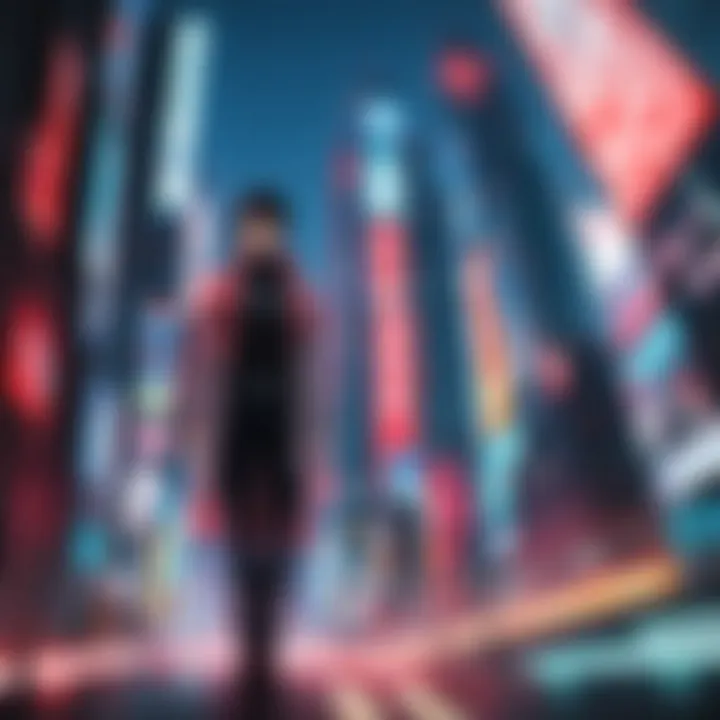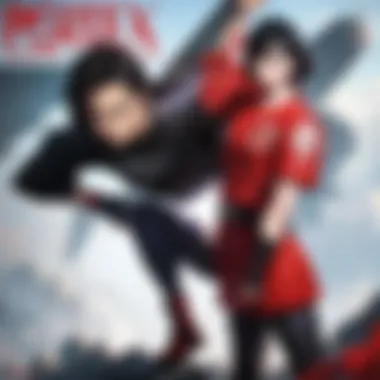In-Depth Analysis of Akira: A 1988 Anime Masterpiece


Intro
In the realm of animated films, few titles evoke as much admiration and curiosity as Akira. Released in 1988 and helmed by the visionary Katsuhiro Otomo, this anime classic not only redefined the animated movie landscape but also became a cultural phenomena. It crafted a narrative steeped in a dystopian future, reflective of Japan's socio-political climate during the late 1980s. But what truly sets Akira apart is its unparalleled animation techniques, compelling storytelling, and complex characters, all wrapped in a rich tapestry of themes that remain relevant to this day.
As we delve into the various components that contribute to Akira's grandeur, we will explore character profiles, thematic elements, and the broader implications of its cultural significance. Understanding these facets offers a glimpse into how the film continues to influence both the anime industry and popular culture around the globe.
Character Profiles
Overview of Main Characters
Akira's character ensemble is not merely a backdrop but rather a lens through which the audience experiences the film’s profound themes.
- Kaneda: The audacious leader of a biker gang, Kaneda embodies youthful rebellion and the search for identity. His fearless demeanor masks deeper uncertainties as he navigates relationships and the growing chaos around him.
- Tetsuo: Once a subordinate in Kaneda's gang, Tetsuo’s transformation into a conduit of immense power presents a tragic downfall. His journey is one of both personal and physical evolution, highlighting themes of friendship, betrayal, and the perils of unregulated ambition.
- Kei: A tenacious member of a resistance group, Kei is a pivotal character who straddles the line between ally and adversary. Her development reflects the struggles of a society grappling with control and freedom.
Supporting Characters
Not to be overlooked, the supporting characters enrich the narrative profoundly.
- Colonel Shikishima: Representing the military authority attempting to restore order, he symbolizes the tension between power and control in a society teetering on the edge.
- Akira: The child with untold psychic powers becomes a focal point in the power struggle, highlighting the dark implications of scientific experimentation.
The interactions and developments of these characters propel the narrative while exploring complex themes of responsibility, the impact of technology, and consequences of societal neglect.
Theme Exploration
Central Themes
Akira bravely confronts a myriad of themes:
- Power and Corruption: The struggle for control over Akira’s powers emphasizes how strength often leads to moral decay, affecting personal and societal integrity.
- Technological Ambivalence: The film illustrates a love-hate relationship with technology, raising questions about its role in human evolution and its potential to devastate.
- Youth Rebellion: The backdrop of a society on the brink fuels the youthful fervor represented by Kaneda and his gang, reflecting a longing for change and identity amidst chaos.
Cultural References
Embedded within Akira are whispers of real-life events, particularly those surrounding modern Japan. The film draws on the post-war anxieties of a nation grappling with rapid industrialization and the age of information. It mirrors the fears of nuclear catastrophes and government manipulation, allowing viewers to see fragments of their own realities within its fictional context.
"Akira holds a mirror to its audience, reflecting not just the fears of its time, but those that continue to resonate into the present."
Popular Series and Recommendations
Top Anime Series of the Year
The impact of Akira and the wave of exhilarating animations has paved the way for many renowned series. Notable mentions include:
- Neon Genesis Evangelion
- Ghost in the Shell
- Cowboy Bebop
These series have drawn inspiration from Akira, continuing to push the boundaries of storytelling and animation quality.
Hidden Gems in Manga
For enthusiasts looking to explore similar narratives in manga, consider adding these to your collection:
- Dragon Head
- Blame!
- Parasyte
These titles echo the themes found in Akira, offering profound insights and thrilling adventures that keep the spirit alive.
As we synthesize the rich themes and compelling characters throughout Akira, it's clear that this film remains not just a classic, but a blueprint for what anime can achieve in storytelling and cultural commentary.
Preface to Akira
The importance of exploring Akira cannot be understated, as this film stands at the crossroads of anime’s evolution. Released in 1988, it offered a radically different narrative and aesthetic that reshaped how the medium was perceived globally. Understanding its nuances not only serves as an appreciation of the film but also illuminates the cultural context that birthed it.
One can't overemphasize how Akira introduced audiences to the darker, more mature side of anime, standing apart from family-friendly animation that was prevalent before. This piece explores the intricate elements that make the film a classic: its profound themes of power, rebellion, and technological advancement. Thus, the following sections will unpack the film’s core components—leading to a deeper understanding of its enduring significance.
Overview of the Film
Akira is set in a post-apocalyptic Neo-Tokyo, a city recovering from a catastrophic event resulting in destruction and desolation. The plot centers on two childhood friends, Kaneda and Tetsuo, whose lives spiral into chaos due to a government experiment involving psychic abilities. Tetsuo’s transformation from an insecure teen into a formidable and tragic force reflects the deeper societal tensions of the time. This narrative is layered, tackling themes like authority, friendship, and societal collapse, making it a multifaceted experience.


The film is characterized by its rich visual storytelling, featuring groundbreaking animation techniques that were almost unparalleled at its time. The use of vibrant colors combined with stark contrasts creates an immersive world that both captivates and unnerves the viewer. The stunning visuals align seamlessly with its relentless pace, keeping audiences glued to the screen. In essence, Akira is not just a film; it's a sensory experience that invites viewers to delve deep into its intricate narrative.
Significance in Anime History
Akira holds a paramount position in the history of anime, serving as a launchpad for a wave of films that favored complexity over simplicity. This film was instrumental in introducing anime to the Western audience, establishing a foothold that would lead to an explosion of interest in the genre.
- Pioneering Themes: It pushed boundaries by addressing challenging subjects such as government corruption and the consequences of uncontrolled advancement in technology.
- Cultural Impact: The visuals and storytelling opened doors for future creators, showing that anime could explore myriad genres, including cyberpunk and dystopian narratives.
- Improvement in Production Standards: Before Akira, anime was often considered niche. Its success escalated production values across the board, influencing studios to invest more in quality storytelling and animation.
"Akira redefined anime for a generation and inspired countless creators, both within and outside Japan."
Through the lens of Akira, one sees a pivotal moment where anime began to permeate mainstream culture. Its legacy continues to thrive, acting as a cornerstone for those who wish to explore the dynamic world of anime.
The Creative Minds Behind Akira
Understanding the creative minds behind Akira is pivotal to appreciating its status as a revolutionary piece of animation. This section delves into the key figures who breathed life into this groundbreaking film, emphasizing their unique contributions and the innovative spirit that defined the project. Specifically, we can look at how Katsuhiro Otomo's vision as director and writer, along with the skills of various animators and artists, shaped the narrative and visual style that captured audiences worldwide. The synergy between these individuals not only pushed the boundaries of anime but also left an indelible mark on the broader film industry.
Director and Writer Katsuhiro Otomo
Katsuhiro Otomo’s role as both the director and writer of Akira cannot be overstated. His unique perspective and multifaceted approach to storytelling played a vital role in navigating the complexities of the plot and its characters. Born in 1954, Otomo’s journey in the world of manga and anime began in the late 1970s with works that often showcased a fascination with mechanisms of power and societal decay. These themes would be instrumental in Akira, which portrays a dystopian future in Neo-Tokyo defined by chaos and desperation.
Otomo's adaptation of his own manga into the film was no small feat. He not only had to condense a sprawling narrative into a two-hour runtime, but he also ensured that the film resonated emotionally while capturing a vivid aesthetic. His insistence on high-quality animation deeply influenced the entire production crew, prompting them to use techniques like detailed hand-drawn frames, which was almost unheard of at the time. It also set high production standards for future anime. Otomo's vision was not merely about the story he wanted to tell, but about how to tell it in a way that had never been seen before.
Otomo’s meticulous attention to detail in both the plot and animation resulted in a film that is both visually striking and thematically profound.
Otomo's insistence on a realistic portrayal of violence and the psychological depth of his characters added layers of complexity that elevated Akira from a mere animated feature to a cinematic experience. His quiet, yet commanding approach helped to ground the film in reality, making the fantastical elements stand out even more. Thus, it’s clear that without Otomo, Akira would not have achieved its pioneering status in anime history.
Key Animators and Artists
The animation in Akira serves as a testament to the collective talent of its animators and artists. They brought Katsuhiro Otomo's vision to life, each adding their flair into the mix. One notable figure is Yoshiyuki Sadamoto, the character designer whose work shaped the memorable looks of Kaneda and Tetsuo. Sadamoto’s acute understanding of character expression vibes well with popular anime aesthetics, making the characters not just memorable, but relatable.
Then we have the meticulous work of animator Takashi Nakamura, who was crucial in conceptualizing the groundbreaking sequences of action that defined Akira. His commitment to fluid motion and detail helped deliver some of the most remarkable sequences seen in animation at that time. The opening motorcycle chase is an exemplary point showcasing this seamless blend of art and motion, which still influences modern animators.
Moreover, the key staff at Tokyo Movie Shinsha, such as production designer Ikuei Matsumoto, played a vital role in establishing the grim atmosphere of Neo-Tokyo. The city is more than just a backdrop; it's a character in itself, filled with towering skyscrapers and an air of despair. The artists transformed Otomo's written words into mesmerizing visuals that urged viewers to immerse themselves in this richly crafted world.
In essence, the collaboration between Otomo and his team reflected a revolutionary model of production that valued creativity and innovation. Through their hard work, Akira not only became a milestone in anime but also set a high bar for future projects in both Japan and worldwide.
Story and Plot Development
Story and plot development plays a crucial role in Akira, as it lays the foundation for the film’s intricate world and thematic depth. The narrative serves not only as a direct vehicle for character expressions and motivations but also reflects the socio-political realities of late 1980s Japan. Understanding the plot’s development enhances our appreciation of how it engages with audiences on multiple levels, touching upon personal struggles and broad societal concerns.
Setting the Scene: Neo-Tokyo
The fictional city of Neo-Tokyo is more than just a backdrop; it's a character in its own right. Established on the ruins of old Tokyo, this landscape is imbued with the paranoia of a post-apocalyptic world. Skyscrapers loom like sentinels, while the streets pulse with the chaotic energy of youth culture and crime. The aesthetic combines cyberpunk elements with traditional Japanese motifs, creating a vibrant yet dystopian atmosphere.
- Akira* effectively uses visual cues to set the tone - neon lights flicker against the darkness, graffiti scrawls the walls, and massive government structures dominate the skyline. It reflects a society grappling with rapid technological advancements and social fragmentation.
This setting is significant for understanding the characters’ struggles. Neo-Tokyo is both a symbol of rebirth and decay, capturing an era where European styles meet Japanese traditions. One could argue that the city's very design reflects the tumult of its inhabitants, caught in the clash between rebellion and oppression.
Character Arcs and Evolution
Character development in Akira is meticulously woven into the overarching narrative. The growth of Kaneda and Tetsuo stands out prominently. Kaneda, the leader of a motorcycle gang, embodies a sense of rebellion and camaraderie. His transformation is about taking responsibility, especially when faced with the consequences of Tetsuo’s actions.
Conversely, Tetsuo transitions from a troubled boy feeling neglected and insignificant to a being of immense power, burdened by his overwhelming abilities. His journey illustrates a classic narrative of ambition and descent into madness, steeped in personal trauma. These contrasting arcs create layers that allow viewers to explore themes of friendship, betrayal, and the insatiable hunger for power.
Notably, supporting characters—like Kei and Colonel Shikishima—also enrich the narrative. Kei, representing a voice of dissent, showcases the potential for resistance against authority. She challenges the boys’ reckless attitudes, adding depth to both character relationships and plot dynamics.
Themes of Power and Control
The film’s themes are a reflection of its glimpse into power dynamics in society. Tetsuo's ascension underscores the corrupting nature of power—once he gains it, he spirals uncontrollably, causing destruction and chaos.
Akira deftly explores the juxtaposition of personal desires against the backdrop of governmental control. The cryptic Akira project embodies the struggles of authority grappling with forces they cannot control. This stands as a metaphor for the societal anxieties of the time—fear of technology, the threat of militarization, and loss of individuality.
The intricate dance between rebellion represented by Kaneda’s gang and the suppressive hand of the government adds another layer to the narrative. The fight against authority isn’t just a plot device, but a call to challenge the status quo, resonating deeply with audiences even today.
"Akira is not just a mere film; it's a reflection of societal unease and the human condition trapped between freedom and control."


Character Analysis
Character Analysis is a vital aspect of delving into Akira's rich narrative framework. In any story, characters serve as the vehicle through which themes and messages are conveyed. Akira boasts a striking array of personalities that not only propel the plot forward but also engender significant emotional and philosophical inquiries for audiences. Understanding these characters — their motivations, dilemmas, and transformations — allows for a deeper appreciation of the film’s intricate web of power dynamics, rebellion, and the human condition.
Kaneda: The Rebellious Hero
At the heart of Akira stands Kaneda, the quintessential rebellious hero. Young, brash, and equipped with unwavering resolve, he embodies the spirit of defiance that underpins the film. Kaneda's character arc begins with him as an impulsive gang member, often seen rushing into danger without much thought. However, his evolution unfolds as he grapples with Tetsuo's tragic descent into obsession and madness. Despite his initial superficiality, his loyalty toward friends and the burden he feels to save Tetsuo showcases a more complex persona.
- Youthful Rebellion: Kaneda's character symbolizes the youthful surge against an oppressive society. His reckless charm attracts various followers, embodying the punk attitude of the late 80s in Japan.
- Inner Conflict: Beneath his tough exterior, Kaneda's inner struggle emerges as he confronts his morality, forcing viewers to see that even heroes face significant choices and changes.
Tetsuo: The Tragic Antagonist
Tetsuo serves as a counterpoint to Kaneda, a portrayal of tragedy cloaked in ambition and desperation. His journey from a meek member of Kaneda's gang to a former student of psychic powers highlights the dangers of unchecked ambition and vulnerability. The film’s dramatic backbone can largely be derived from Tetsuo's internal battles and uncontrollable powers. Where Kaneda represents hope and rebellion, Tetsuo represents the tragic consequences when power corrupts.
- Descent into Madness: His evolution is a powerful reminder of how external pressures can warp someone’s identity. Caught in the relentless grip of his abilities, Tetsuo becomes an embodiment of chaos that takes a toll on both himself and others.
- Power and Isolation: Tetsuo's transformation illustrates that power does not equate to personal strength. Instead, it often leads to isolation and despair, creating a poignant narrative about the cost of greatness.
Supporting Characters: Their Roles and Impact
While Kaneda and Tetsuo are undeniably central, Akira flourishes with an array of supporting characters that enrich the narrative. Each character, though often understated, serves a purpose in framing the psychological warfare and societal commentary that the film presents.
- Kiyoko, the Oracle: A figure hinting at fate and destiny, Kiyoko represents the potential for knowledge yet warns against the misuse of power. Her mystical presence acts as a catalyst, leading characters toward pivotal moments of realization.
- Colonel Shikishima: As a military figure caught between duty and safeguarding his city, he presents a stark contrast to the chaotic energy of Kaneda and Tetsuo. The Colonel encapsulates the conflict between the need for order and the desire for personal freedom in a rapidly-changing society.
Visual and Technical Mastery
In any animated film, the visual and technical elements often serve as the backbone of storytelling. Akira is no stranger to this principle. The myriad of animation techniques and cinematic methods used in the film enhances not just the visual experience but also deepens the narrative. These elements help to embroider a tale that resonates with themes of power, rebellion, and transformation in a dystopian setting, and they hold a vital place in the legacy of anime as a genre.
Animation Techniques and Innovations
Akira broke the mold for animation during its time, introducing several groundbreaking techniques that would leave an indelible mark on the industry. One of the most notable features is the use of hand-drawn cel animation, which was meticulously crafted to achieve intricacy and fluidity that many films couldn't even dream of. With more than 160,000 individual frames, each meticulously painted, it set the standard for visual quality in animation.
The film also used a technique known as layered animation. Instead of simply painting over backgrounds, animators utilized multiple layers to create depth. For instance, the high-tech bikes that Kaneda and Tetsuo ride don’t just look fast; they’re animated in a way that feels as if they’re barreling through Neo-Tokyo at breakneck speeds. The shadows, reflections, and details on the bikes contribute to a sense of realism that engages viewers in a way that’s almost palpable.
Another significant contribution came from the color palette. The vibrant hues contrasted with darker tones highlighted the chaotic nature of Neo-Tokyo, effectively reflecting the film’s overarching themes of destruction and rebirth. This nuanced use of color also allows for smoother transitions in dramatic moments, elevating the emotional gravity mid-scene.
Moreover, the animators embraced the limited animation technique in specific instances, opting to focus intricately on key movements while sacrificing the fluidity of less essential actions. This decisively drew the audience’s attention to what mattered most, like the tense confrontation scenes between characters. Thus, these innovations did not merely function as aesthetic aspects, but rather as cohesive storytelling tools.
Cinematic Techniques Used
Beyond animation, Akira adopted several cinematic techniques typical in live-action films, but highly innovative for animation of that time. One standout approach was the use of framing and composition. Little details like angles and shots were astutely considered to establish focus on characters’ emotions or to exaggerate the scale of Neo-Tokyo’s towering buildings. This artistry in framing created a chaotic backdrop that somehow complemented the turmoil experienced by the characters.
Moreover, Akira expertly employed the montage technique to juxtapose scenes, crafting an unsettling rhythm that mirrors the film's relentless pace. Rapid edits between contrasting visuals—such as the desolate cityscape and the frenetic energy of the characters’ journeys—not only make the experience more engaging but elevate the urgency of their mission.
The absence of a traditional score in some moments stands as another notable technique. By utilizing silence or ambient sound, the film effectively immerses the audience in the tension, leaving them on the edge of their seats. When the music does crescendo, that sense of anticipation amplifies, ensuring the impact of those musical moments is profound.
As Akira's story unfolds, the masterful application of these cinematic techniques doesn’t merely augment the visual quality but greatly enriches the narrative experience. Together, the combination of cutting-edge animation and innovative cinematic techniques crafts a compelling world that continues to resonate with audiences decades after its release.
Musical Score and Sound Design
The musical score and sound design of Akira plays a pivotal role in shaping the film's rich atmosphere and emotional undertones. The work of composer Geinoh Yamashirogumi intertwines traditional Japanese instruments with modern soundscapes, creating a unique auditory experience. This innovative blending not only enhances the narrative but also mirrors the tumultuous world of Neo-Tokyo, where chaos and rebirth coexist. The importance of these elements cannot be understated, as they serve to deepen viewers' immersion into the film, making them feel as though they are part of the unfolding drama.
Soundtrack's Influence on Atmosphere
One of the most striking features of the Akira soundtrack is how it complements the visual elements and heightens the sense of urgency. From the very start, the haunting wails of traditional instruments set a tone that is both disconcerting and majestic, engaging the audience's senses immediately. In moments of intense action, the frenetic beats inject adrenaline into the scene, compelling the viewer to experience every pulse of Kaneda's motorcycle chase or Tetsuo's transformative awakening.
Additionally, quieter moments are accentuated through deliberate silences and minimalist sounds, creating a stark contrast that amplifies emotional depth. The lull before chaos often fosters a sense of dread, effectively prompting the audience to brace for what’s about to unfold. The use of ambient sounds — from the bustling streets of Neo-Tokyo to the distant echoes of bomb detonations — enriches the viewing experience, grounding it in a palpable reality that resonates beyond the screen.
The Role of Voice Acting
Voice acting in Akira is another essential facet of its sound design that demands appreciation. The performances by the talented cast, including Johnny Yong Bosch and Mitsuo Iwata, breathe life into characters, endowing them with distinct personalities. Their delivery captures a wide range of emotions, underscoring the internal struggles faced by Kaneda and Tetsuo.
Moreover, the choice of voice actors helps bridge cultural and linguistic gaps. For instance, the English dubbed version found significant success abroad, owing in part to the performances that conveyed the characters’ motivations and turmoil effectively.
"Akira's voice acting skilfully channels the deep emotionality of characters, making their arcs feel profoundly relatable, no matter where you’re from."
As viewers navigate the complex relationships and social dynamics within Neo-Tokyo, the interactions enriched through voice delivery enhance the narrative’s impact. This is particularly evident in pivotal scenes where dialogue sheds light on underlying themes of power, rebellion, and identity. Therefore, from the rhythmic beats of the score to the compelling voice performances, the sound design in Akira stands as a testament to its artistry, contributing to the film’s lasting influence and emotional weight.


Cultural and Historical Context
Understanding the cultural and historical context of an influential piece like Akira is paramount. This film not only reflects the zeitgeist of its time but also serves as a historical artifact illustrating Japan’s turbulent socio-political landscape during the late 1980s. The events surrounding Akira's production and release provide critical insights into the film's narrative themes and character developments. Furthermore, examining the reception it garnered globally helps to contextualize Akira's impact on both the anime industry and popular culture at large.
Japan's Socio-Political Landscape in the Eighties
During the 1980s, Japan stood at a crossroads of rapid economic growth and significant societal change. The nation's economy flourished, driven by a booming technology sector and exports. Yet, beneath this veneer of success lay deep-seated tensions. Young people felt increasingly alienated from the rigid structures of authority. This sense of dissatisfaction and disillusionment can be palpably felt in Akira's characters and storyline.
The film is set in a post-apocalyptic Neo-Tokyo, a city plagued by the scars of governmental negligence and rampant militarization. This mirrors the growing anxiety felt by many about the state’s increasing control over individual liberties. Notably, the youth, represented by characters such as Kaneda and Tetsuo, serve as embodiments of rebellion against oppressive systems. They reflect the desire for agency in a society that often stifled it.
Akira was released in 1988, just prior to the burst of the economic bubble in Japan, a critical point that would see a downturn in the nation’s fortunes. The film encapsulates the uncertainty and chaos that surrounded the country during this time. As power dynamics shifted, Akira’s portrayal of government corruption and the loss of individual freedoms resonated with audiences. This socio-political backdrop tells us much about the film's enduring themes.
Global Reception and Impact
When Akira hit the global stage, it was a revelation for many outside Japan. Critics heralded it for its breathtaking animation, complex narrative, and rich thematic depth. Within a few years, it captured the hearts of audiences worldwide, paving the way for anime's emergence into mainstream consciousness.
Akira's success can be attributed to a few critical elements:
- Visual Splendor: The visual artistry presented a stark departure from typical animations. Detail-oriented backgrounds and fluid movements enchanted viewers and set a new standard for animated features across the globe.
- Complex Narratives: Unlike many Western animations, Akira was unafraid to delve into darker themes of power, control, and societal decay. Its willingness to challenge audiences made it stand out, raising eyebrows and sparking discussions.
- Cultural Foreignness: Many international viewers were captivated by the uniquely Japanese sci-fi aesthetics and narrative styles, drawing a distinct line between Akira and other sci-fi works of its time.
"Akira is a perfect storm of visual flair and thematic gravity — a testament to the potential of anime as sophisticated storytelling."
The film's influence persists, appearing in numerous Western media properties and inspiring a generation of filmmakers and animators both in Japan and abroad. The seeds planted by Akira in 1988 blossomed into a global appreciation for anime, altering the landscape of how animation is perceived and produced.
As we reflect on Akira's historical context and reception, its ability to resonate with audiences remains undisputed — a testament to its artistry and profound thematic narratives.
Akira's Legacy
Akira stands as a monumental pillar in the landscape of anime and popular culture. Released in 1988, it not only pushed the boundaries of animation but also ignited a revolution in storytelling, artistry, and thematic depth. To adequately understand the weight of its legacy, one must consider the multifaceted impact it had on subsequent works, the genre itself, and how it prompted dialogue beyond the confines of Japanese media.
Influence on Future Anime
The ripples of Akira's influence can be seen clearly in various anime that followed. The film redefined what anime could achieve, both visually and thematically. It showcased that mature narratives could be successfully explored through animation—a notion that was often dismissed prior.
Notable series like Neon Genesis Evangelion and Cowboy Bebop owe much to the groundwork laid by Akira. Characters became more complex, and stories began to delve into psychological and societal issues without adhering exclusively to escapism. The film's narrative style, notably, employed a slow burn that built suspense while exploring profound themes of power and rebellion, prompting creators to consider depth and nuance in their storytelling.
This leap forward has influenced many renowned anime creators. Behind the scenes, both Hayao Miyazaki and Shinichiro Watanabe have cited Akira as a cornerstone that shaped their artistic ambitions and narrative aspirations. These creators carried the torch, infusing their works with the profound gravitas and stylistic innovation that Akira championed. This legacy extends into the realm of themes too—an exploration of dystopia, loss of self, and the consequences of unchecked technological advancement—issues that remain resonant in today’s world.
Crossover into Mainstream Media
Akira didn’t merely stay within the confines of anime; its allure drew the attention of mainstream audiences and a myriad of creative domains. The visceral visuals, coupled with its haunting soundtrack composed by Tokushi Doi, captured imaginations not just in Japan but globally. Mainstream filmmakers and artists began to take notice. The film's aesthetic and message permeated Hollywood, influencing American blockbusters like The Matrix and Inception, where the blend of sci-fi elements with philosophical overtones became a staple.
Furthermore, its manga origins, penned by Katsuhiro Otomo, paved the way for adaptations within the film industry, hinting at the potential success of animated adaptations. Shows like Avatar: The Last Airbender drew inspiration from the stylization and world-building that Akira mastered.
The aesthetic choices, too, made their mark. The intricate details of cityscapes, along with cyberpunk themes, began to appear in video games, particularly in series like Cyberpunk 2077 and Ghost in the Shell, inviting a future of cross-pollination between entertainment mediums.
"Akira not only redefined anime; it also broadened the horizons for what storytelling could be across all mediums."
Final Thoughts on Akira
The film Akira doesn’t just stand as a classic in the anime genre; it’s a benchmark against which many cinematic works are measured. Reflecting on this movie highlights not just its artistic value, but also its profound commentary on society, technology, and human emotion. This section delves into the enduring significance of Akira, its survival through the shifting landscape of both animation and popular culture, and the lessons it offers for current and future generations of creators and viewers alike.
Enduring Relevance and Contemporary Resonance
Even though it burst onto screens in 1988, Akira is astonishingly relevant today. The themes of power dynamics, rebellion against oppressive systems, and the consequences of unchecked technological advancement resonate deeply with our current global environment.
The tale of Tetsuo, consumed by desires for power and identity, mirrors the struggles faced by individuals in today's fast-paced, tech-driven world. In an age where technological innovations shape daily life and societal hierarchies appear more rigid, the film echoes truths about personal autonomy, youth rebellion, and societal decay that are felt anew in the twenty-first century. Its dystopian vision is alarming, yet it serves as a cautionary tale, urging viewers to remain vigilant against societal complacency. As we witness movements fueled by young voices challenging authority, the story of Akira offers a potent mirror reflecting these ongoing battles.
There’s also an artistic revival of interest in anime, with shows and films paying homage to the groundbreaking techniques first displayed in Akira. The meticulous attention to detail in animation, as well as the complex narrative structure, sets a lofty bar for today’s creators who seek to push the bounds of storytelling and visual language, also inspiring upcoming projects — from films to series on popular streaming platforms.
Recommendations for Further Viewing
For those captivated by the richness of Akira, there exists a treasure trove of films and series worthy of exploration:
- Ghost in the Shell - This 1995 classic marries philosophy with cyberpunk themes, paralleling Akira's exploration of identity and technology.
- Neon Genesis Evangelion - A landmark series that dives into psychological and existential issues, set against a backdrop of mechs and apocalyptic struggles.
- Perfect Blue - Directed by Satoshi Kon, this psychological thriller tackles themes of identity and reality, showcasing the darker side of fame.
Anime enthusiasts may also find the influence of Akira woven throughout a variety of contemporary films: shows like Attack on Titan and Psycho-Pass draw on themes of societal collapse, governance, and rebellion. For a broader spectrum of art, films like Blade Runner 2049 and The Matrix echo Akira's dystopian aesthetics and profound questions about human existence.
A comprehensive viewing experience of these recommendations can further enrich understanding and appreciation of Akira's legacy within the anime landscape and beyond.
"Akira continues to influence not just a genre but the very fabric of storytelling across media. It opens the door for discussions about power, identity, and the human condition, making it an indispensable piece of modern art."
By exploring such films and series, one can appreciate the momentum Akira has provided within the industry while continuing to engage with its core themes deeply.







